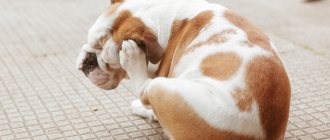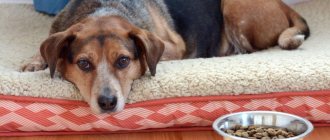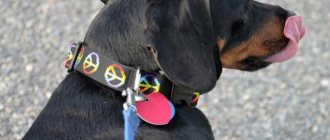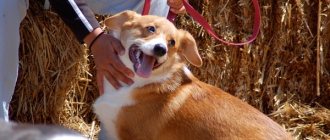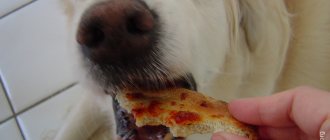Many dogs have dominant behavior. They try to make a person indulge their desires. This does not depend on the size of the pet: even mini dogs can subjugate the whole family. Such an animal requires discipline. This is especially true for the street. Dogs may get excited during a walk and pull on the leash. This leads to injuries and substitution of authority. Therefore, you need to know how to wean your dog from pulling on the leash while walking.
Why does the dog pull on the leash?
One of the common problems that dog owners face is controlling their behavior on the street. Many dogs begin to tug on the leash, causing discomfort to themselves and their owner. As a result, the pleasure of walking is lost. Animals often injure their necks and suffer from suffocation attacks. To wean your dog from pulling on the leash, you need to understand what motivates it. The main reasons for this behavior:
- Imposing a route. The animal does not respect the owner enough and sets the direction of movement. As a result, the dog begins to walk the person.
- Owner's mistakes. It’s not easy to wean your dog off a bad habit on your own. People often use the jerk method without realizing that they are contributing to an unwanted reaction. Before the jerk, the tension on the leash is released, which causes the pet to associate it with pain. Tension = safety.
- Excited state. Dogs can be mentally unstable. They break from the leash, cannot concentrate on a walk, and bark constantly and loudly. Such animals should be handled by an instructor and a zoopsychologist. Psychological problems cannot be solved by house training.
- Using a roulette leash. This type of ammunition causes heated debate among dog lovers. One of the main disadvantages of roulette is that the dog controls the distance. In addition, the leash is constantly taut. The animal gets used to the lack of air and considers it normal.
Non-standard behavior is always justified. The owner should not treat the pet as a trespasser. He has no goal to annoy a person. The first thing you need to understand is that dogs don't think like people.
What to do
First you need to decide on the rules of upbringing and stop making things worse.
The rules imply that for successful parenting you need:
- Patience. The dog will not learn to perform the “near” command in one repetition. Especially stubborn - or stupid - this will take two to three weeks.
- Consistency. Any action reinforces some behavior. Every time you take your pet for a walk, you need to remember that the entire hour and a half will be part of the educational process. You cannot set aside ten separate minutes on the playground and the rest of the time allow your pet to tug and pull wherever he wants. It will only confuse him.
- Motivation. The dog must understand that by following the rules, some benefit awaits him. If you ignore his desires and, even if he obeys unquestioningly, choose a direction that is not interesting to him, he will quickly return to his previous style of behavior.
- Praise. Learning can happen without punishment, but not without praise. The dog should receive encouragement when it does what the owner wants: when it keeps pace with him, when he checks that the leash is not tight, when he does not try to break away and run away. First, you need to reward every time. When the behavior becomes established, the number of rewards is reduced and made irregular so that the dog does not lose interest.
You won't be able to train a dog through violence - you can only intimidate it and make it nervous.
It is much better to use encouragement: kind words, stroking, wild delight, applause. You can give the dog treats, but not more often than once every three rewards in general, otherwise he will get full and stop being interested in what is happening.
In addition, before you begin to practice commands and behavior during a walk, you need to remove the collar and play with your pet so that it releases energy. When he gets a little tired, you can start exercising. Otherwise, jerks, uncoordinated movements and attempts to break off the leash cannot be avoided.
Video
To understand how training occurs, you can watch a video of a professional dog handler working. No violence, no yelling, no hitting, no prong collar or shock collar. Extremely self-confident and understanding of how a dog's head works.
Methods for weaning yourself from pulling
When training your dog, you need to give up the tape measure and choose a leash of medium length: from 3 to 5 m. It is very important not to change it during training. If necessary, you can change the collar. Many dogs continue to break away from the roulette wheel even after successful training. In order not to provoke a “relapse”, it is recommended to refuse it. Also, jerk training is excluded from training. The insidiousness of this method was described above.
For training to be worthwhile, you need to follow simple rules:
- Do not change direction depending on the dog's wishes. When the pet starts to pull on the leash, you need to stop, turn in the other direction and lead the dog with you. You can move like a snake, figure eight, and loop around the site. This will make your pet understand that ease of movement depends on coordinated actions.
- If the pet has done everything correctly, it must be praised. You cannot raise a dog by shouting and swearing. This provokes a desire to run away, which means pulling on the leash. Obedience should have a positive response.
- The leash must be of constant length. It can be three or five meters. It is fixed in two positions: when the dog is at the leg and at full length. This will help optimize the learning process.
- Avoid using a leash. Even rare use can provoke an “attack” of disobedience.
- Change direction as often as possible. If the pet does not know where the person will go, he will be forced to follow the route.
- Learning starts with simple things. The first classes are carried out in a calm, irritant-free place. There should be no cats, cars, passers-by people or dogs. The difficulty level should be increased gradually. The same applies to the duration of classes. A dog that is not accustomed to regular lessons will not be able to maintain attention for long.
A puppy should not be put on a leash before the fourth month of life. At this time, you need to allow him to communicate with his relatives and learn their “language.” If a dog is protected from its relatives, it will grow up withdrawn and unadapted. Don't worry if your baby starts to break from the leash: it won't be difficult to wean your puppy off the bad habit.
If the owner does not give the pet minimal freedom during a walk, it begins to react aggressively to the leash: gnawing on it and trying to free itself. This occurs due to tugging, a ban on approaching relatives, and an uncomfortable length.
In some cases, the dog chews on the leash to manipulate the person. The dog notices that when he bites into the leash, the owner lets him run free and starts playing. The dog uses this technique to attract attention. To discourage your dog from playing with a leash, you can create unpleasant associations. For example, “shoot” with a water pistol or lightly hit the rump when she grabs the ammunition.
The method of switching attention is no less effective. As soon as the pet begins to chew on the leash, the owner takes out a toy or object for fetching. You need to throw the leash on the ground and show the dog the toy. When he concentrates on the object, you need to pick up the ammunition and continue the walk, distracting the dog with a toy.
Choosing the right ammunition
Ammunition is of great importance. Without a properly selected leash and collar, training is pointless. An uncomfortable collar can cause aggression. Some owners specifically buy ammunition that causes pain to speed up the learning process.
You can't do that. The collar should be comfortable and of the correct size and width. Pet stores offer a wide range of ammunition, which can be difficult to choose from. The most popular types:
- Leash. It is a durable tape with a loop handle. The ends of the tape are equipped with a carabiner. It can be short, medium (3-5 m) and long/loose (10-12 m). Medium is optimal for walking, free - for training.
- Roulette leash. Convenient for walking, but not suitable for dogs that strain from their leash. The tape measure is constantly tense, so the animal quickly gets used to the unpleasant sensation, and it is more difficult to influence it. Not suitable for training.
- Short leash. It is a short cord with a loop handle. Equipped with a carabiner. Designed for "close" walking, not suitable for training.
- Parfors. This is a barbed collar for training hunting dogs. There are spikes on the inner surface. Suitable for training hunting breeds and used in exceptional (!) cases.
- Noose. The collar tightens like a noose when the dog begins to tear. Training with a noose is justified in the case of large, difficult-to-control animals.
- Halter. During tension, it compresses the dog's muzzle, not the neck. Outwardly similar to a muzzle, but designed to correct behavior. With its help, dogs are trained to walk next to their owner and not pull on the leash.
- Electroshock collar. Operates in vibration warning mode and electric shock mode. The force of the discharge is comparable to a shock of static electricity. Used for training aggressive dogs.
- Harness. Ideal for well-mannered dogs. Does not restrict movement and does not put pressure on the neck.
If you choose the right equipment, your training will be successful. To wean an adult dog from pulling on a leash, it is recommended to buy a halter. The pressure in the muzzle area will be unusual for the pet, and he will try to readjust.
What to do if the moment is missed?
You should pay attention to the above points in time, but, unfortunately, there is not always enough time to raise a dog. How to solve the problem in this case?
You can try the following options:
- Change the collar so that, as with a puppy, it can be fastened securely, preventing it from being pulled over the head and access to the free end.
- Try metal collars and leashes - chewing on them is not nearly as pleasant as leather or fabric models.
- Buy a special anti-rodent agent and treat the collar and leash with it. It has an unpleasant taste, so the desire to try an object treated with it on the tooth will quickly disappear.
- Pamper your pet with a toy or a long-lasting treat; it is quite possible that his teeth are simply itchy, or that the collar and leash are associated with play.
- If such behavior is observed only during a walk, it may be worth purchasing a muzzle, which simply will not leave the opportunity to chew through the leash and collar. But in this case, do not forget that the pet should be properly accustomed to it in order to avoid a similar problem.
Reward and punishment - mistakes of owners
The training process is impossible without encouragement and approval. There is no need to scold the dog and move in its direction: it will try to avoid “retribution” and will pull the leash with redoubled force. The pet must voluntarily follow the owner’s commands, so success is rewarded with treats and affection.
Often the training process is delayed due to mistakes by the owners. These include:
- Following the dog. It is important not to forget that the owner walks the pet, and not vice versa! The animal needs to be given room to maneuver so that it can sniff the marks and communicate with its relatives. At the same time, the route is chosen by the owner. It determines the degree of freedom and sets the direction of movement.
- Encouraging arousal. Nervous dogs should be distracted with toys or fetch, rather than having their wishes granted.
- Jerk method. As already mentioned, dogs quickly get used to educational measures, even if they are unpleasant. The dog will associate a tight leash with a comfort zone, and a loose leash will expect pain. Therefore, it is better to abandon this method.
The training should be on a positive note. The dog does not understand the meaning of training. She behaves the way she is used to. The pet does not know why the owner uses brute force: education should be accompanied by encouragement.
If the owner exercises the dog regularly and correctly, the results will not be long in coming. You can train puppies and adult dogs. The main thing is to find an approach to them.
Why is she doing this?
If your four-legged friend could talk, he would definitely explain his behavior to you. But since he can’t do this, we can only guess why he didn’t like the leash or, conversely, liked the taste of the collar.
This behavior can have several reasons.
Firstly, it may be caused by negative emotions associated with the walk. It happens that dogs begin to growl or hide at the sight of a collar or leash. Trying to eat it is exactly the same expression of protest.
There may be several reasons for dislike of the mandatory attributes of a walk, but most often it is caused by an incorrect approach to education and, as a result, unpleasant memories. Perhaps the owner used force and shouted at the pet when he was just getting used to wearing a collar, or pulled the leash when the stupid puppy tried to play with him or pull him in the wrong direction. All this can have unpleasant consequences for the animal - one sight of these objects and the feeling of a noose around the neck can immediately cause a defensive reaction and attempts to free itself.
Secondly, there is a high probability that the owner chose the first collar incorrectly and did not pay due attention when training the puppy.
To avoid such problems you need to:
- Buying the right collar is best made of synthetic material with smooth length adjustment and a plastic carabiner clasp. The fact is that many people immediately buy a leather collar for their puppy “for growth.” After fastening it, a long dangling “tail” remains, which the pet begins to chew with pleasure. If this is not prevented, the habit of eating the collar will remain in the adult dog. Synthetic models have a design in which the free end of the collar is securely hidden.
- To put it on correctly, a finger, or at least two, should fit freely between the collar and the animal’s neck. This way he will not choke the pet, and it will be difficult to bite him.
- Distract from a new thing when training - you should keep the puppy busy with play so that he quickly gets used to the collar and does not pay attention to it.



